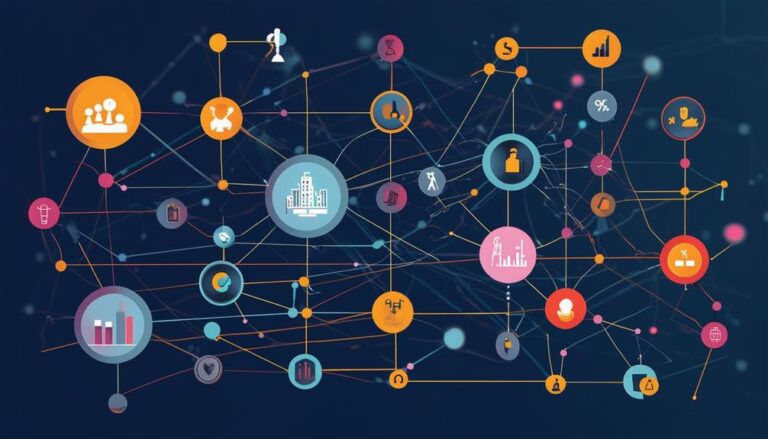Vertical Merger Examples in the Market

We've witnessed a variety of fascinating vertical merger instances in the market. One notable example is AT&T's acquisition of Time Warner, which aimed to create mobile entertainment offerings.
Similarly, Ikea's purchase of forests to control raw materials showcases a strategic move towards vertical integration. Walt Disney's merger with Pixar combined cutting-edge animation with global distribution capabilities, resulting in a powerful combination in the entertainment industry.
Additionally, FMCG companies integrating with advertising agencies have driven innovation through strategic partnerships.
These strategic combinations are designed to streamline operations, boost efficiency, and enhance overall quality within the organizations. However, they often come under legal scrutiny and face cultural challenges due to the complex nature of vertical mergers.
By understanding the intricacies of successful vertical mergers, companies can potentially gain a competitive edge in their respective industries.
Key Takeaways
- AT&T's acquisition of Time Warner to offer comprehensive mobile entertainment packages.
- Ikea's purchase of forests to secure a sustainable supply chain for furniture manufacturing.
- Walt Disney's merger with Pixar to revolutionize the animated film industry.
- FMCG companies joining forces with advertising agencies to drive creativity and product development.
- Textile firms partnering with cotton yarn manufacturers to enhance their competitive edge.
What Are Vertical Mergers?
Vertical mergers combine companies at different points in the supply chain to streamline operations, cut costs, and boost efficiency in the production-to-consumption process. By merging with firms in complementary stages of the supply chain, businesses can seize control over the entire process, leading to cost savings and better overall performance.
Unlike horizontal mergers, where companies join forces with direct competitors, vertical mergers involve partners at distinct stages of the chain, like a manufacturer teaming up with a distributor. For instance, a car maker might acquire a parts supplier or a retailer could buy a logistics firm. Through these integrations, companies can manage expenses, enhance product quality, and optimize the flow of goods.
The primary aim of vertical mergers is to create synergies that improve the supply chain as a whole.
Synergies Created by Vertical Mergers
Vertical mergers create synergies by enhancing coordination between different stages of the supply chain. This improved coordination leads to more efficient processes, reduced costs, and better integration. By bringing together suppliers and manufacturers, vertical mergers enable companies to have better control over quality, production timelines, and distribution channels. This results in improved communication, data sharing, and decision-making throughout the supply chain.
Cost reduction is a significant synergy generated by vertical mergers. These mergers streamline processes, eliminate redundancies, and ultimately improve profit margins. Additionally, vertical mergers enhance quality control by tightly integrating production and distribution, ensuring consistent product quality and reliability. Moreover, they promote responsiveness through faster decision-making and information sharing, enhancing the ability to adapt to market changes.
Another key synergy created by vertical mergers is innovation. By combining complementary capabilities, companies can develop new products and services that wouldn't have been possible otherwise. This focus on innovation not only benefits the companies involved but also drives growth and competitiveness in the market. Overall, vertical mergers aim to maximize value creation by optimizing the relationship between suppliers and manufacturers, ultimately benefiting customers and stakeholders.
Advantages and Disadvantages of Vertical Mergers

Vertical mergers offer a key advantage in streamlining operations throughout the supply chain, potentially boosting profits and enhancing cost management. Successful cases have demonstrated how vertical integration can improve supply chain efficiency and overall profitability for the combined entity. By controlling more aspects of the value chain, companies can ensure higher quality standards for their products and services, enhancing consistency and reliability for customers.
Despite these benefits, vertical mergers come with their share of challenges. The task of integrating different corporate cultures and overcoming employee resistance can prove to be difficult. Additionally, managing a more intricate, vertically-integrated business incurs extra costs. It's crucial to note that vertical mergers are subject to increased legal scrutiny regarding antitrust issues, necessitating careful navigation of regulatory obstacles.
The Main Challenges of a Successful Merger
Vertical mergers offer the potential for streamlining supply chain operations and improving quality control. However, it's crucial to acknowledge the significant challenges that can hinder their success. One key obstacle is the integration of different organizational cultures and management styles from the merging companies, which can create conflicts and hinder effective collaboration.
Moreover, legal scrutiny poses a common concern, especially regarding the merged entity's control over raw materials, which may trigger antitrust issues. Understanding the benefits and drawbacks of a vertical merger is essential for its success. Evaluating the expected synergy gains and ensuring they align with the company's strategic goals are equally vital.
Ultimately, the success of a vertical merger depends on how well the merging companies navigate these challenges and stay focused on their long-term objectives. By addressing cultural, legal, and financial complexities early on, businesses can enhance their chances of achieving a truly successful vertical merger.
Vertical Merger Examples in the Market

Looking at actual cases can help us see the advantages of vertical mergers. AT&T's merger with Time Warner aimed to boost their mobile entertainment offerings. Ikea's acquisition of forests allowed them to have control over raw materials. Similarly, Walt Disney's merger with Pixar focused on driving growth through cutting-edge animation films.
In the case of AT&T and Time Warner, the vertical merger led to robust mobile entertainment services. By owning forests in Romania and the Baltic region, Ikea gained a strategic advantage with control over raw materials. Walt Disney's merger with Pixar enabled them to create innovative animation films that captivated audiences worldwide.
Vertical mergers can offer companies a deeper insight into their brand identity, increased control over essential resources, and enhanced operational efficiencies. For instance, fast-moving consumer goods (FMCG) companies merging with advertising agencies and textile firms integrating with cotton yarn manufacturers showcase how organizations leverage vertical integration to foster innovation and gain a competitive edge in the market.
Frequently Asked Questions
What Are Some Examples of Vertical Mergers?
Absolutely! Some fascinating examples of vertical mergers include the integration of a streaming platform with a movie production studio and a pharmaceutical company acquiring a biotechnology research firm. These strategic moves allow companies to streamline their operations, reduce costs, and gain a competitive edge in the market.
Another noteworthy vertical merger is when a telecommunications provider merges with a content creation company, enabling them to offer bundled services to customers and expand their reach in the entertainment industry. By combining their expertise and resources, these companies can deliver innovative products and services to meet consumer demands effectively.
In the healthcare sector, we've seen vertical mergers where a hospital chain acquires a medical equipment manufacturing company. This integration helps improve patient care by ensuring seamless access to state-of-the-art medical devices and technologies within the hospital network. It also enhances operational efficiency and promotes collaboration between healthcare professionals and equipment developers.
These examples illustrate how vertical mergers can create synergies, drive growth, and enhance overall performance for companies across various industries. By strategically aligning different parts of the supply chain, businesses can achieve greater economies of scale and deliver better value to their customers.
Which of the Following Is an Example of a Vertical Merger?
Vertical mergers play a crucial role in streamlining operations and optimizing the supply chain. A classic example of such a merger can be seen in Apple's acquisition of Beats Electronics. This move allowed Apple to seamlessly integrate hardware and software, ultimately enhancing their product offerings and customer experience.
Vertical mergers, like the one between Apple and Beats Electronics, can lead to greater efficiency and control over the production process. By bringing together complementary capabilities, companies can achieve synergies that drive innovation and competitive advantage in the market.
In the case of Apple and Beats Electronics, the merger not only expanded Apple's product portfolio but also strengthened their position in the music and entertainment industry. This strategic move enabled Apple to leverage Beats Electronics' expertise in audio technology while integrating it with their own hardware and software ecosystem.
Is Ikea a Vertical Merger?
Ikea's acquisition of forestland exemplifies a vertical merger in the realm of mergers and acquisitions. By taking control of the raw material supply chain, Ikea ensures a sustainable source of wood for its products, thus boosting operational efficiency. This strategic move positions Ikea to manage the entire production process from sourcing to manufacturing, enabling greater control and oversight. This vertical integration not only streamlines operations but also secures a reliable and environmentally conscious supply of wood for its furniture lines.
Is Disney and Pixar a Horizontal or Vertical Merger?
Disney's acquisition of Pixar represents a vertical merger where we integrate different stages of the production process. By bringing Pixar's animation expertise in-house, we can now control the creation of our animated films from start to finish. This allows us to streamline our operations, improve efficiency, and maintain a competitive edge in the market.
Vertical mergers like the one between Disney and Pixar often lead to synergies that benefit both companies involved. In this case, Disney gains access to Pixar's cutting-edge technology and creative talent, while Pixar can leverage Disney's vast distribution network and marketing resources. The combined strengths of both companies create a powerful force in the animated film industry.
Moreover, vertical integration can result in cost savings and increased profitability. By eliminating the need to outsource animation production, Disney can reduce expenses and improve profit margins. This strategic move not only enhances our creative potential but also strengthens our market position in the highly competitive entertainment industry.
Conclusion
Vertical mergers are common in the market. One example is the merger between AT&T and Time Warner. AT&T, a telecommunications giant, acquired Time Warner, a media company, to vertically integrate its services and content. This merger allowed AT&T to offer a wide range of services to its customers, from mobile phone plans to popular TV shows and movies.
Another example is the merger between CVS Health, a pharmacy chain, and Aetna, a health insurance company. By joining forces, CVS Health and Aetna aimed to create a seamless healthcare experience for their customers. This vertical integration allowed them to combine pharmacy services with health insurance coverage, leading to more efficient and affordable healthcare solutions.
Vertical mergers like these can create synergies between companies operating in different stages of the same industry. By vertically integrating their operations, companies can streamline processes, reduce costs, and improve the overall customer experience.





